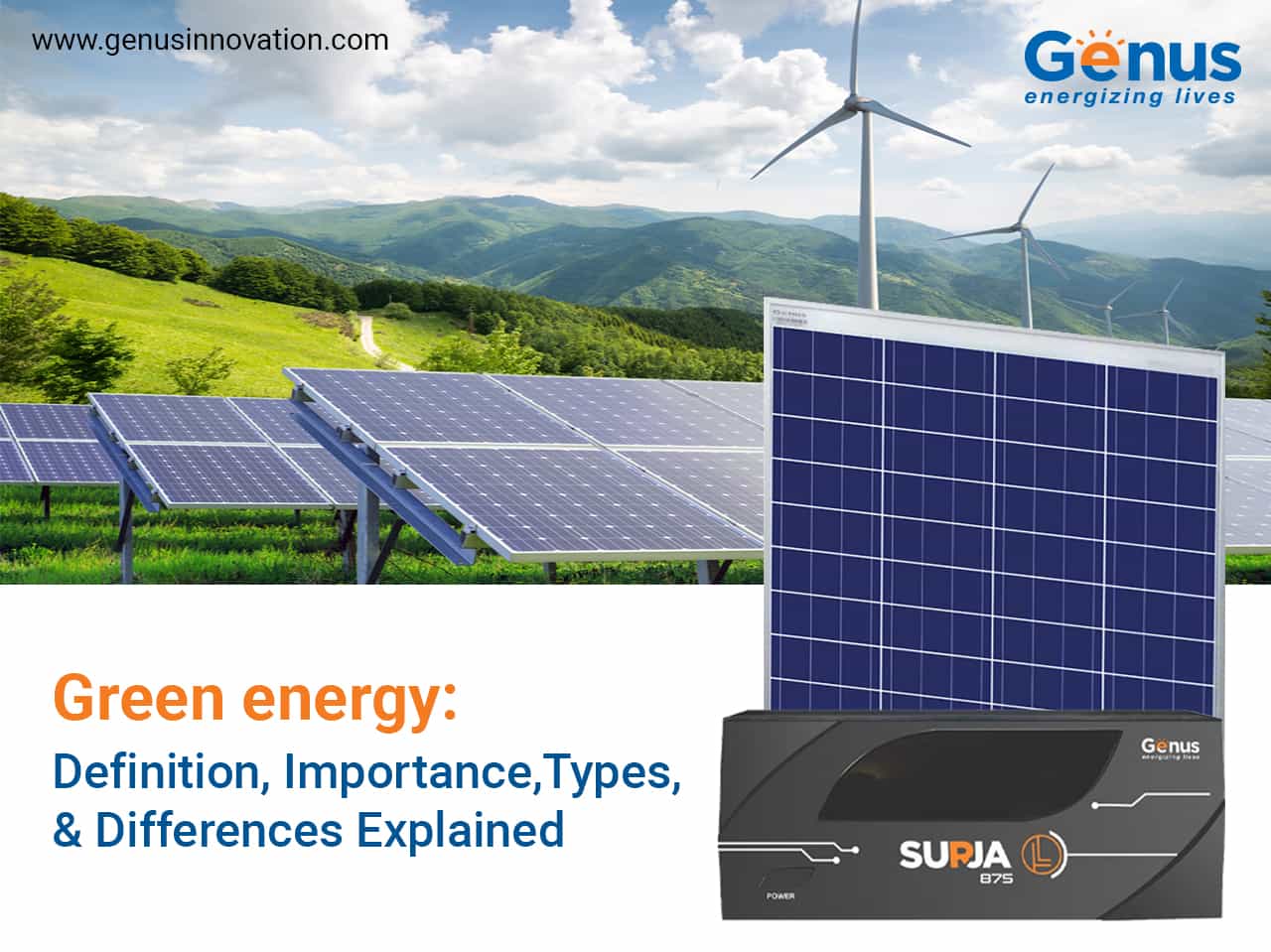
What is green energy?
Green energy or green power is one type of energy that is generated from natural assets like sunlight, water, or wind. These are infinite and natural entities, hence the energy generated does not emit greenhouse gasses and harm the environment. Genus Innovation uses green power as a great solution to sustainable energy usage. We provide the most efficient solar products for home that use green energy for added climate protection.

How does green energy help the environment?
Green power is important for the environment for multiple reasons.
- It replaces the damaging effects of fossil fuels with alternative resources like wind, water, and sunlight. These are clean, renewable, and more friendly to the environment.
- Even in the entire life cycle of a green energy source, they emit a very less amount of greenhouse gases, thereby reducing the amount of pollution and damage in nature and saving the planet.
- Green power is also cost-effective and stable since the sources are produced locally. Also, price spikes, geographical crises, or supply-chain disruptions don’t impact the sources. A Genus inverter battery is designed to provide a small amount of electricity for a longer period of time. So these are the best household and commercial fits for places where frequent power outages are common.
- There are also economic benefits including job creation. Back in 2018, renewable energy created 11 million jobs in the whole world (source: TWI Global).
- Since the energy production is through sources like wind and solar power, the energy infrastructure is more resilient and is less dependent on centralised sources, thereby leading to disruption as well as being less flexible to weather-related climate change.
- Green power also embodies a solution that is low-priced for the energy needs of different parts of the world.
How many types of green energy are there?
There are a few types of green energy that come from different types of natural sources and these are:
1. Solar energy
As the name suggests, solar is a clean source of energy that comes directly from the sun. Generally, the stars produce a vast amount of energy with the help of nuclear fusion. This is a process by which smaller atoms are fused together by pressure and heat to generate heavier atoms. A whole lot of energy is emitted in the process of fusion, which reaches us via solar radiation. We can then collect and convert it into usable electrical power.
A Genus solar system for home can be the best pick if you wish to save limited energy resources and switch to green power. However, solar energy is the most common way of harvesting solar energy. There are plenty of photovoltaic cells. So when sunlight hits the cells, they generate an electrical current through the photoelectric effect. Then the current generated is passed through an inverter to turn it into an alternating current. From there, it can be utilized to power up your home.
2. Wind energy
Another major energy source is wind energy which is powered by the sun. Since winds are caused by the uneven heating of the atmosphere, the sun is somewhere responsible for generating wind energy. However, on that unevenness, the topology of our planet, its spin, and how the entire living species orbit around the sun have an impact. Further, winds are modulated by the surface they are passing through – either water or land. Wind power does not generate carbon dioxide or emit any harmful products that negatively impact human health like acid rain, smog, or other heat-trapping gases.
However, a solar tubular battery by Genus comes with extended service life and helps your long power backup requirements. It can help your energy needs as you embrace green energy for your home or office.
3. Hydroelectric energy
Hydroelectric energy is generated by capturing the energy from flowing water. Experts force water to flow through a narrow space, thereby increasing the energy per square meter. Generally, in this process, water is stored in a dam or reservoir and purged selectively by opening an intake. And the procedure follows through with some critical applications.
However, hydroelectricity is one of the most popular and efficient forms of green energy. This energy is very versatile and can be produced using both large-scale projects and small-scale projects. Hydroelectric power does not emit pollution and hence it’s very much friendly to the entire ecosystem.
4. Biogas
Biogas is made of waste products and is another great source of green power. It is produced as a byproduct when organic matter decomposes and comes from materials like food, sewage, manure, agricultural waste, and so on. These materials are stored in a container where oxygen can not reach. This causes them to ferment and generate carbon dioxide, methane, and other gases. The methane then is used to fuel vehicles, produce electricity, heat homes, and so on. Also, the waste is put into a biogas digester and is turned into nutrient-rich fertilizer for home and farm use.
5. Biomass
Biomass, just like biogas, is a source of clean energy that is generated from recently living organisms and plants. They both contain energy that they get from the sun. Although the burning of these materials emits greenhouse gases, these emissions are still lesser than those from fossil fuels.
Biomass can be utilized in a variety of ways in our daily lives. Its usage is not limited to personal consumption, businesses also can get benefit from this energy source. However, switching to the best solar products for home can help you save the limited energy sources as well as your electricity bills. And consuming more green energy for your daily lives can save the planet in the long run.
Is there any difference between green energy and renewable energy?
Although the terms “green energy” and “renewable energy” are often used interchangeably, there are slight differences between the two. The former comes from natural sources such as the sun, whereas the latter comes from sources that are continuously being restored like solar energy, wind power, hydropower, etc.
Green power is indeed a subset of renewable energy and includes those resources that provide more benefits to the environment. Hence, all resources for green power are renewable, but not all resources for renewable energy are considered green. An Inverter battery is a super powerful and energy-efficient product that supplies energy for an extended period of time. Generally, they last for 3 – 4 years, but with Genus, you get added electrical benefits for sure.
Genus Innovation is a leading manufacturer of multiple eco-friendly solar power products. Saving the earth with smart products that use environment-friendly energy resources is precisely what we aim at. So if you wish to opt for the same for your home or office space, get in touch with us.
